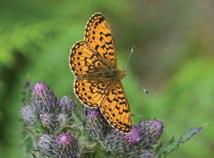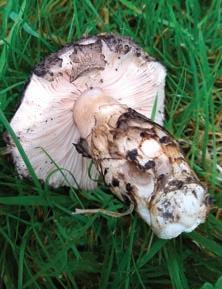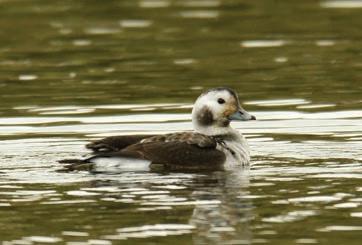
14 minute read
New Discoveries
Butterflies - Bob Hall
Skippers Dingy Skipper and Grizzled Skipper are still both very restricted in their distribution, with three records for Dingy only from Ewyas Harold Common while Grizzled has been found at The Doward and Ewyas Harold Common. Small Skipper had a maximum count of 30 from Urishay Court Farm and 27 from Garway Common. Large Skipper are quite widespread in the county with a maximum of 12 from Haugh Wood. A few records of Essex Skipper, but this is almost certainly under-recorded on account of difficulty in identification. Whites
Advertisement
There were plenty of Brimstone records with a highest count of seven from Dulas. Plenty of Orange Tips in April with a large count of 11 from Haugh Wood. Small White and Green Veined White were quite common with a max count of 30 for Green Veined White from Breinton and eight Small White from Bull’s Hill. Small White had a good summer brood with a remarkable count of 50 plus from Mrs Janette Fulwood at Risbury. Large White were again common with a high count of eight from Haugh Wood. Wood White have had a poor year even in their strongholds of Wigmore Rolls and Haugh Wood (10 max). Wood White were also recorded in Seige Wood (max 10). There was a partial second brood of Wood White in Haugh Wood. A single record of Clouded Yellow was reported from Bodenham Lake. Browns
Gatekeeper (max 48 from Ewyas Harold Common), Meadow Brown (max 200 plus from Urishay and 138 from Oak Tree NR) and Ringlets (max 60 at Urishay) all had good breeding seasons. There were good counts of 30 plus Marbled White from Nupend, Urishay Court Farm and Woodside HWT reserve, but the population at Wessington HWT reserve has almost disappeared. Speckled Woods were widespread with a high count of 12 from Devereux Park. There were four records of Wall from Brampton Wood, Hanter Hill, Old Ashmoor and Merbach Hill (max two). Low numbers of Small Heath records from Hanter Hill (max 18) and other spots near Kington . Fritillaries
There was a maximum count of 21 Dark Green Fritillary from Bradnor Hill. Pearl bordered Fritillary numbers were slightly down even at Ewyas Harold Common with a high count
Orange Tip (male)
of 80. Three were recorded at Coppett Hill. There were no records from Haugh Wood. Small pearl bordered Fritillary were recorded from Hanter Hill and Ewyas Harold Common with a high count of 8 from Hergest Ridge. Silver Washed Fritillary had a good season with a high count of 16 from Haugh Wood. The rare dark form of Valezina was spotted in Checkley. Theresa de la Fuente submitted a record of High Brown Fritillary found and identified by her father, Small Pearl Bordered Fritillary Roy Strange, in Brampton Bryan Woods in July 1980. Nymphalidae There were few early records of either Comma or Red Admiral, but numbers picked up in mid summer , with a high count of 10 Comma and 15 Red Admiral from Haugh Wood . Small Tortoiseshell numbers too were generally low except for a fine count of 26 from Pontshill. 45 Peacocks were recorded from Haugh Wood in late July . White Admiral was recorded in Checkley but not elsewhere. Painted Lady records were mostly individuals but were well distributed. A high count of 8 from Haugh Wood. Blues There were plenty of early records of Holly Blue and a partial second brood. Common Blue had a poor year with a high count of 15 from Urishay Court Farm, but there was an improvement in numbers of the second brood. Tom Oliver counted a remarkable 234 in five minutes on an uncut piece of field at Urishay in mid August.
Purple Hairstreak Holly Blue
There were three records for Green Hairstreak from Hergest Ridge. Purple Hairstreak were recorded from Buckenhill, Haugh Wood , The Doward, and Wofferwood Common with a maximum count of 19 from Mick Colquhoun in Haugh Wood at the height of the summer heat in July. They had descended from the oak trees and were sheltering from the sun underneath the oak leaves. White letter Hairstreak were again seen in Haugh Wood nectaring on Hemp Agrimony or high up in elm trees with a maximum of three from Hoarwithy. There were four records of Brown Argus from Colwall, Haugh Wood, Wessington HWT reserve and Sutton Walls. Small Copper were seen in small numbers in late summer from a variety of sites. Acknowledgements This summary has been compiled with records from these recorders : Philip Bauer, Liam Bunce, Sarah Cadwallader, Mick Colquhoun, Ian Curtis, Ian Draycott, Tony Eveleigh, Dean Fenton, Jill Fountain, Toby Fountain, Bob and Penny Hall, Ian Hart, David Hemming, Dr Richard Kippax, Tom Oliver, Viv Quinn, Jeremy and Katherine Soulsby, Heather Walker, Richard Wheeler and Jane Wise. Recording The West Midlands branch of Butterfly Conservation adopted iRecord for submitting records in 2017. The iRecord website is hosted by the national Biological Records Centre. To use iRecord : 1. Go to www.brc.ac.uk/irecord 2.Register user name and password. 3. Click on the Record tab. 4. Select the type of record you wish to submit. A record must contain four essential pieces of information : who, which species, where and the date seen.
All records are then checked by verifiers for each county. For Herefordshire the verifiers are currently Ian Draycott and myself. Website: www.westmidlands-butterflies.org.uk
Plants
- Stuart Hedley
Much of the action this year seems to concern water and swamp plants. Jonanthan Forsyth found Narrow-leaved Water-plantain Alisma lanceolatum at Hampton Bishop, confirming one of the more charming of all field characters for this difficult pair: Water-plantain flowers from 1 to 7pm, whereas this, its rarer sibling, flowers from 9am until 2!! At the other end of the County, Will Watson completed a project to restore the pond at Berrington Hall, resulting in superb, clear macrophyte-rich water (now tragically rare with us until the crisis in the upper catchment of our rivers is resolved) with an abundance of Horned Pondweed
Zannichellia palustris. Will also did well in spotting Pedunculate Club-rush Bolboschoenus laticarpus in a pond near Wormelow – this is effectively the first record of this plant in Herefordshire as an older record of a Bolboschoenus Club-rush from Mathon had been made prior to taxonomic revision of the genus. Six plants of Corky-fruited water-dropwort Oenanthe pimpinelloides were spotted in a haymeadow near Almeley. Although clearly a recent arrival they looked very much at home and, unlike the only other county record from a park on the edge of Hereford, perhaps stand a good chance of spreading. Pride of place this year goes to Hilary Wallace’s find of True Foxsedge Carex vulpina at The Sturts, however. A nationally-rare and Vulnerable sedge more than 50km west of its current known limit. Growing with Slender Tufted-sedge Carex acuta for which new sites at Hereford and Leintwardine were also found.
Back into the water, the compilation of a poster for the Woolhope Club drew the chronic lack or recent records for pondweeds to my attention, though Blunt-leaved Pondweed Potamogeton obtusifolius surfaced in the far north-west of the County and Bog Pondweed Potamogeton polygonifolius appeared at a totally new site following scrape creation in one of our handful of peaty basin mires. At Shucknall Hill Spring Cinquefoil Potentilla verna was re-found in good quantity after an absence from the record of almost exactly sixty years. Quite a showy plant, but not as much as the marsh-orchid hybrid Dactylorhiza x hallii that popped up not far from Monmouth, the third time for Herefordshire. We might expect more in future given the increasing spread of Southern Marsh-orchid, one of its parents. Finally, it has been a good year for records for one of our most cryptic grass species, Brown Bent Agrostis vinealis, which defeats most field ecologists from Kent to Cumbria. Three new sites, two of them on the Brownstones Formation at Cefn Hill and Garway Common respectively, and a third at Broadmoor Common near Woolhope. All show the plants predilection for sandy free-draining soils, so some more targeted searches are needed!
Dragonflies - Chris Harris
There were a total of 292 dragonfly records submitted to iRecord during 2021 covering 19 species, down from 586 records and 20 species in the previous year. At time of writing, there were 228 records covering 20 species submitted for 2022. The marked reduction in the number of dragonfly records over the last few years is concerning and may be related to COVID and a reduction in the number of recorders. Certainly, many of the UK’s dragonflies are currently benefiting from the effects of climate change; the 2021 BDS State of Dragonflies report shows that 41% of species showed an increase in occupancy, while just 11% showed significant decline. Please send in any records you have yet to submit. During 2021, the earliest record submitted was for a Large Red damselfly (Pyrrhosoma nymphula) on 6th May, almost a month later than the previous year. This is almost certainly related to a cooler than average Spring and an exceptionally wet May delaying emergence (or keeping recorders indoors). The latest record was for a Migrant Hawker (Aeshna mixta) on 19th November, almost two weeks later than the previous year, which can be accounted for by exceptionally mild weather; 2021 was the third warmest Autumn on record.
During 2022, the earlier record was, you’ve guessed it, a Large Red damselfly on 29th April. Common Darter was the latest sighting (so far) on 3rd November. Red-eyed damselfly (Erythromma najas), which first appeared in the county back in 2019, continues its move westwards, popping up at Berrington Hall. There were only a few records for this species over the last two years but it may be being under-recorded. If you’re out and about in June and July, look for this species on still water with lots of floating vegetation; mature males like to adopt lily pads and other floating plants as territorial platforms. It can also be found on slow-flowing rivers and has benefited from floating mats of algae caused by agricultural pollution. As previously predicted, Scarce Chaser (Libellula fulva) made its first appearance in the county in May 2022 near Mathon. Thanks to David Taft and Jane Tavener for a county first record.
Other notable records during 2022 include Golden-ringed dragonfly (Cordulegaster boltonii) at Longtown in the Black Mountains and Red-veined darter (Sympetrum fonscolombii) at Berrington Hall. The latter is a migrant species arriving from Spain and North Africa, although it has been shown that Spring arrivals often breed in the UK, producing a second generation in the Autumn.
Fungi
- Jo Weightman
Although the dry conditions of 2021 discouraged the fungus population as a whole from fruiting, the year was not without interest as the following notes testify. The nationally rare Orchard Toothcrust Sarcodontia crocea was first recorded in the county in 2014 at Awnells Farm, in a cleft of the trunk of an old Warner King apple tree and continued to fruit there for several years. The original host tree has now died but in October 2021 the fungus was recorded on an old Newton Wonder tree in the same orchard. So far, it has not been recorded elsewhere in the county. Devils Claw Clathrus archeri has spread further north in the county, having been seen in October on Bircher Common near Orleton. This is the third Herefordshire record for an Australasian species seen mostly in the southern counties of the UK. As it is a phalloid, like the Stink horn, it relies on the flight of a fly or a gust of fly carrying wind for its spread. Loreleia postii was recorded several times in Herefordshire in the nineteenth century but currently is only known from Kentchurch Court where it was first recorded in 2016 and recorded again, although at a different place, in November 2021. Devil`s Bolete Rubroboletus (Boletus) satanas. This bolete was recorded at Eastnor and Moor Park in the nineteenth century but since then has been seen only on the Doward where it has frruited with some regularity. The young specimen found on 29.09.2021 during an HFSG meeting was making quite a late appearance for a species most commonly reported in Herefordshire in August or September. Two handsome species of Webcap both in the Phlegmacium group of the Cortinarii were also reported at the same meeting on the Doward. Both have few records in the county.
The Webcap Cortinarius splendens has only three previous records, two on the Doward and one on the Wigmore Rolls: Beautiful Webcap C. calochrous was recorded three times in the nineteenth century at Ledbury and on Dinmore Hill and a further three times since 1980, all on the Doward. Like the bolete above, they are restricted to calcareous sites. Lilac Oysterling Panus conchatus is an occasional species occurring, usually in groups, on logs and stumps of broadleaved trees. The cap is lilac purple, fading to tan or brown at maturity and the stipe has purple hairs at the base. Moccas Hill Wood, July 2021. Tiger Sawgill Lentinus tigrinus, a second county find, Hampton Bishop 06.06.2021. The first find is only known from one of the paintings by Dr Bull, which are held at RBG Kew. This fungus occurs mainly on branches , usually of willow, that are seasonally inundated. The second English name refers to the edge of the gills which is toothed. The Unexpected Amanita Saproamanita (Amanita) inopinata Leominster area 27.10.2021. An exciting collection in Kent in 1981 was declared new to science, causing amazement that such a large and distinctive agaric could have escaped observation so long. Since then it has spread into a number of sites mainly in the south east but this is by far its most western location so far. While most occurrences have been near conifers, it has also sometimes been recorded near broadleaves, as on this occasion and is thought to be not mycorrhizal. I t does appear to favour sites disturbed in some way by man. At first there was some doubt even to its genus (it was first picked in mistake for a parasol mushroom thanks to the thick fibrous warts on the cap) and recently it has been moved from Amanita to Saproamanita which at least acknowledges its difference from a ‘normal’ Amanita. For a while it was thought to hail from Saproamanita inopinata 2021 New Zealand but this is now discounted and to date the place of origin is still unknown.

Birds
- Michael Colquhoun
There have been few surprises in 2022 up to the time of writing (November). The start of the year saw occasional records of Mediterranean and Caspian Gulls that have become a regular feature in recent years. There were single sightings of Pink-footed and White-fronted goose, which are unusual species in the county. Several sightings of Cattle Egret (with up to four roosting at Wellington Gravel Pits in April) provided further evidence of this species’ gradual colonisation of Britain. A pair of Ring-necked Ducks took up residence at Wellington in February, staying for six weeks before moving on, presumably to breed elsewhere. Unusual waders have been thin on the ground with only single records of Sanderling, Wood Sandpiper and Red-necked Phalarope, the latter entertaining people at Brockhall Gravel Pits for ten days in September before continuing its migration. An Osprey that stayed at Hartleton Lakes for 24 hours in September was both accessible and fairly confiding, often flying around with small fish that it caught and perching on trees on the islands.
The fourth quarter of the year has seen a Long-tailed Duck and Common Scoter, both at Brockhall. A Pink-footed Goose, again at Brockhall, stayed for three weeks. A Snow Bunting was seen at British Camp at the end of October.
Long-tailed duck (Michael Colquhoun)
Moths

See westmidlandsmoths.co.uk for latest sightings.
Herefordshire Wildlife Trust’s vision is for a Herefordshire richer and more diverse in wildlife, bringing its people closer to nature.
What we do: • We manage 60 Nature Reserves - over 500 hectares of land reserved for wildlife. • We run projects within landscapes across the county restoring habitats and protecting wildlife species. • We work with children and young people in communities and schools engaging, inspiring and educating them about wildlife. • We run events and workshops for adults and provide professional training for volunteers and trainees.
We are supported by over 6,500 members from across Herefordshire and beyond and are assisted in all elements of our work by a fantastic 500 volunteers!
We are a member of the Royal Society of Wildlife Trusts, a federation of 46 Wildlife Trusts covering the whole of the British Isles, with over 800,000 members and more than 2,300 nature reserves covering 90,000 hectares.
Herefordshire Wildlife Trust
Queenswood Country Park & Arboretum Dinmore Hill, Nr Leominster, Herefordshire HR6 0PY
enquiries@herefordshirewt.co.uk www.herefordshirewt.org
Social icon
Circle
Only use blue and/or white.
For more details check out our Brand Guidelines.










